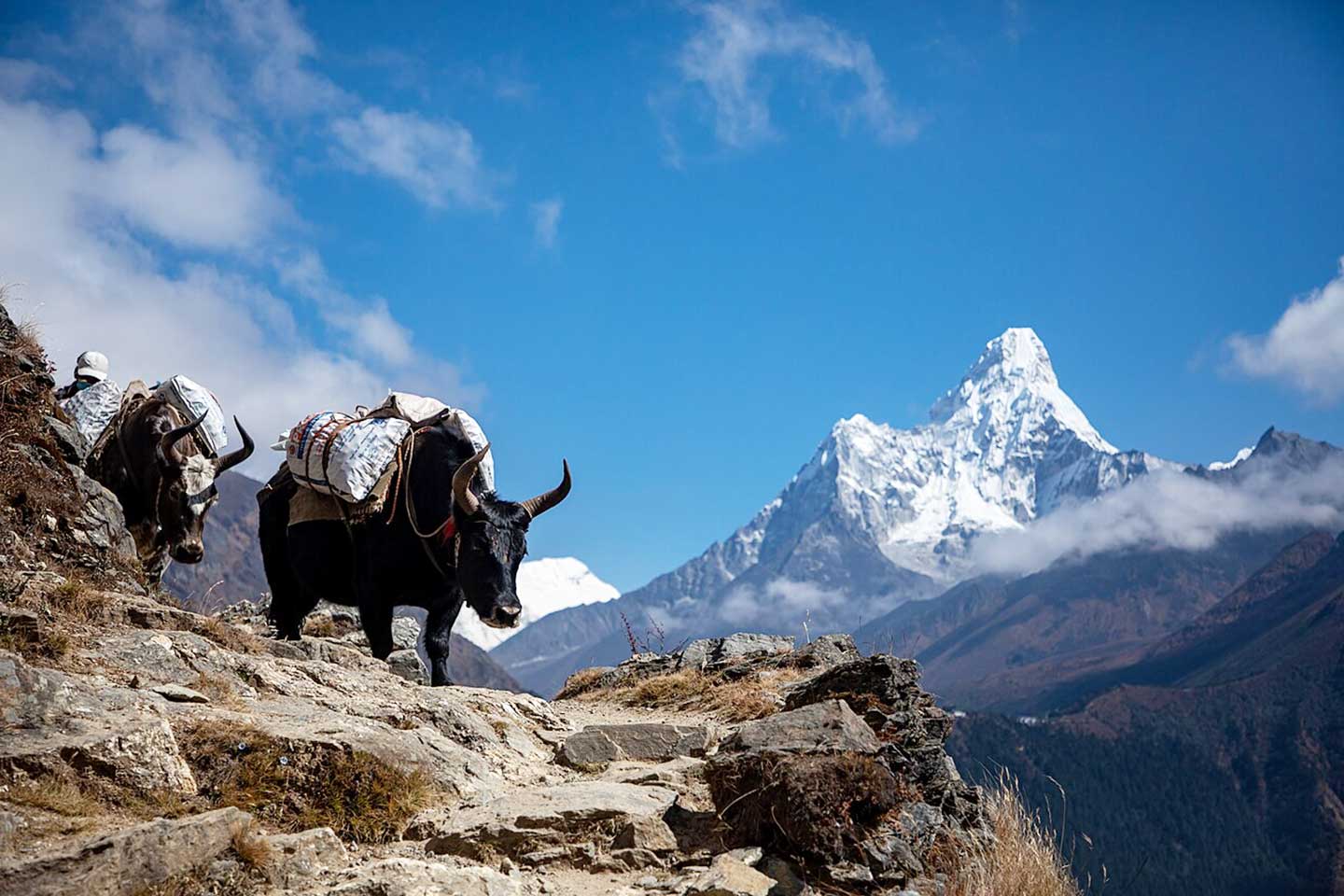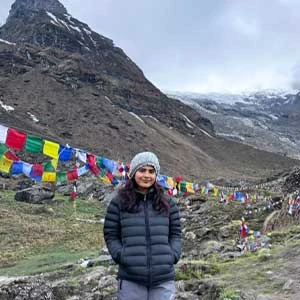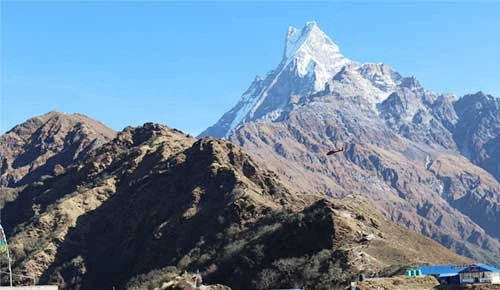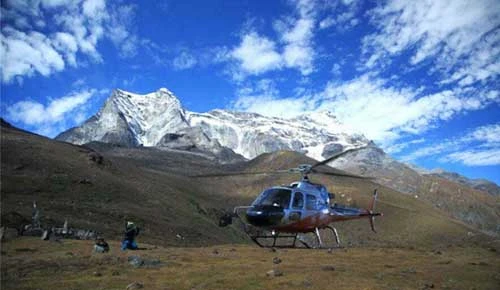Ama Dablam: Nepal’s Most Scenic and Challenging Peak
Ama Dablam is one of the most breathtaking and visible mountains in the Himalayas. Ama Dablam means "Mother's Necklace" in Nepali, where "dablam" refers to the traditional pendant worn by Sherpa women and "ama" means mother. The mountain has both spiritual and cultural significance for the local communities because of its long ridges and hanging glacier, which are said to resemble a mother shielding her child.
Experienced climbers love Ama Dablam because of its technical difficulty and beauty. The most popular route is still the Southwest Ridge, which was first ascended in 1961 by an international team under the leadership of Sir Edmund Hillary. Ama Dablam is a true climber's mountain and a breathtaking highlight for anyone trekking through the Everest region, despite being smaller than nearby giants like Everest and Lhotse, due to its steep faces, exposed ridges, and dramatic shape.
Ama Dablam in the Heart of Nepal
Ama Dablam stands in the Khumbu region of northeastern Nepal, within the Solukhumbu District of Province No. 1. Just southeast of Mount Everest and Lhotse, between the Dudh Koshi and Imja Khola valleys, it rises to 6,812 meters (22,349 feet). The mountain is easily visible along the traditional Everest Base Camp trail and is located close to Pangboche village, approximately 20 kilometers northeast of Namche Bazaar. Trekkers traveling through the Everest region frequently use the viewpoint from Tengboche Monastery because it provides one of the most stunning views of Ama Dablam.
Among all Himalayan peaks, Ama Dablam is often called one of the most beautiful mountains in Nepal. Its peak turns silver at night and golden at dawn, and its ridges look like extended arms. Trekkers have a hard time looking away from it, and they often stop to take pictures of how beautiful it is. For visitors, it is an unforgettable part of the Everest region, and for climbers, it is famous for its hard technical challenges and beautiful views.

Table of Contents
Why Is Ama Dablam the Scenic Peak?
It is smaller than Everest but technically difficult with exposed cliffs, hanging glaciers and steep ridges. Besides testing the physical endurance and strength of the climber, the expedition also puts to test a climber's technical skills and mental acuity, as well as their ability to react quickly and effectively in unpredictable Himalayan weather conditions at high altitudes. Meticulous preparation, proper acclimatisation and respect for the technicality of the mountain are all required to succeed. Here is what makes Ama Dablam special among all the peaks of the Himalaya:
- A lovely hanging glacier on a pyramidal-shaped massif
- Shifting colours throughout the day in changing light of the Himalayas
- Serenity hovering over Sherpa settlements and monasteries
- A symbol of spiritual security and the beauty of nature
- Great for photographers and climbers on the Everest trail. It is the emotional and cultural epicenter of Khumbu.
- The most graceful mountain in Nepal. It is a fine form of adventure, beauty and peace in one object
Climbing Ama Dablam: Difficulty and Technical Challenges
Ama Dablam is one of the most incredible but difficult climbs in the Himalayas. A little shorter than Everest, its steep ridges, hanging glaciers and exposed faces make it a technically tough climb. The trip is a challenge not only of physical strength and endurance but also of mental focus, technical skills and the capacity to acclimate to high elevation and capricious Himalayan weather. You need a strategy, you need to acclimatize and above all, you must respect the complexity of the mountain. Here are some of the challenges and technical problems climbers face:
Steep Rock and Ice Faces:
Ama Dablam’s imposing rock and ice walls are among its most distinctive features. Ascending vertical and near-vertical sections requires advanced technical skills. Careful foot and hand placement and judicious use of rope, as well as concentration, are required to prevent slipping when climbing up these pitches. It requires physical strength and endurance because even a small mistake in your decision-making could be catastrophic, particularly on icy or brittle rock sections.
Narrow and Exposed Ridges:
The climb is full of thin ridges, which are also another major obstacle. Given that most of these ridges are only a few feet wide, with precipitous drops adjacent to both edges, this makes for an exposed and terrifying environment. Jumping quickly over these takes a great deal of composure, confidence and equilibrium. The exposure can be psychologically demanding, because climbers must grapple with their fear while focusing on every step.
Mixed Climbing Terrain:
Rock, ice and snow can all be found on the Ama Dablam route, sometimes even in unison. Actively reposition from the snow/ice layer to the rock under your own consideration of conditions. Note: Good mixed skills are essential for safe climbing in mixed terrain; poor ones endanger everybody and should induce a change of plans! In this type of technical terrain, the correct utilization of tools like crampons, ice axes, harnesses and fixed ropes is also a must. Riding these surfaces as they tumble about requires a climber’s agility and technique.
High Altitude Challenges:
Each step becomes more laborious at 6,812 meters (22,349 feet), with the lower oxygen. Climbers run the risk of suffering altitude-related illnesses, for instance, Acute Mountain Sickness (AMS), which can cause headaches, nausea and dizziness, and potentially life-threatening conditions if not treated. Proper acclimatization, pacing and hydration are necessary to prevent and treat high-altitude sickness.
Rapidly Changing Weather:
The weather in Khumbu is erratic and very bad. Climbers already there may have to adjust plans or wait in unsafe conditions as sudden temperature drops, high winds and snowstorms hit. Besides impeding progress, these weather changes can transform already difficult sections into more dangerous terrain, increasing the risk of hypothermia, frostbite or slips.
Lengthy and Demanding Expedition:
Climbing Ama Dablam typically takes 4–6 weeks, including trekking, acclimatization, and summit attempts. The long duration requires physical endurance, mental patience, and consistent energy management. Extended exposure to cold, altitude, and physically demanding terrain can lead to cumulative fatigue, testing a climber’s resilience at every stage.
Technical Equipment Required:
It is impossible to succeed on Ama Dablam without certain climbing equipment. For both safety and advancement, climbers mainly rely on ropes, ice axes, crampons, harnesses, and protective gear. It is essential to understand how to use this equipment properly in difficult situations because misuse can cause delays or accidents.
Mental and Emotional Pressure
Ama Dablam tests mental toughness in addition to physical power. Steep terrain, exposure, erratic weather, and high altitude can all be mentally taxing. Throughout the climb, climbers must maintain composure, self-assurance, and concentration while controlling anxiety and stress and making accurate choices under duress.

Trekking to Ama Dablam Base Camp
The trek to Ama Dablam Base Camp is a unique mix of adventure, natural beauty and cultural experience. Unlike the strenuous trek to the top, this journey provides many fit hikers with a taste of high-altitude scenery and Himalayan life. The trail gradually passes through a Sherpa village, surrounded by thick jungle to reach Tengboche and visits a monastery. Tyangboche is well known as a spot for trekking. On the way down to Dingbuche, the peak of Ama Dablam looks awesome. Since each section has its own good spot threfore the trek is rewarding even if you are not planning to reach the peak. An in-depth guide to the trekking trail and what you can expect on the way to Ama Dablam Base Camp is below:
- Beginning: Lukla The trek kicks off with a scenic flight to Lukla, where trekkers meet up with the traditional Everest base camp route. Lukla itself is enveloped in terraced fields and pine forests, a foretaste of the trail ahead.
- Sherpa Villages – Phakding, Monjo and Namche Bazaar: Enjoy a glimpse into Sherpa traditions such as stone houses, prayer flags and mani walls. The largest town in the Khumbu region, Namche Bazaar serves as a hub for trekking supplies and has marvelous views of neighboring peaks.
- Gradual Elevation: The path winds through rich pine and rhododendron forests at lower altitudes before reaching an alpine area. This slow ascent allows trekkers to acclimatize as they wander amid the colorful vegetation and occasional animals one encounters along the way.
- Panorama of Himalayas: Throughout the track, Ama Dablam commands the horizon. Furthermore, trekkers are rewarded with stunning views of Everest, Lhotse, Nuptse and others towering far above you; this is the most photogenic experience of the entire trek.
- Pangboche and Tengboche Monasteries are some of the cultural highlights get into detail about Sherpa Buddhism and religious ceremonies at these monasteries. Chanting Monks, ancient murals and colorful prayer flags add cultural depth to the trek.
- Altitude Acclimatization: The trekking route gradually ascends to around 4,570 meters (15,000 ft) at Ama Dablam Base Camp. This slow gain in elevation helps trekkers adjust to high altitude, reducing the risk of altitude sickness while preparing those who plan to attempt the summit.
- Ama Dablam Base Camp: Located at approximately 4,570 meters, the Base Camp offers dramatic, up-close views of the mountain’s southwest face. It’s the best spot for photography, reflection, and experiencing the raw grandeur of the Himalayas.
Best Time to Climb
Spring (March–May) and autumn (September–November) are the best seasons to climb Ama Dablam due to stable weather, clear skies, and optimal mountain visibility. The area comes alive with blooming rhododendrons and vibrant alpine scenery in the spring, when temperatures range from -10°C to 10°C. This time of year offers pleasant trekking conditions, which are perfect for taking pictures and taking in the splendor of the Khumbu Valley as you progressively ascend toward the base of Ama Dablam.
Autumn offers some of the best panoramic views of Ama Dablam and nearby Himalayan giants like Everest, Lhotse, and Nuptse. It also brings dry trails, crisp air, and temperatures between -12°C and 8°C. Climbers and trekkers can access the area more easily during this season because helicopter flights are more dependable. With temperatures as low as -20°C, winter (December–February) is chilly and snowy, providing experienced explorers with the right equipment with a peaceful, enchanted experience. However, because of the heavy rains, slick roads, and poor visibility during the monsoon season (June–August), it is usually not advised. Selecting spring or autumn guarantees the safest, most aesthetically pleasing, and most pleasurable trip to Ama Dablam.
A Mountain, A Journey, A Story
There’s a feeling that stays with you when you face a mountain like this: the mix of awe, excitement, and quiet respect for something far greater than yourself. Every step of the expedition challenges you, yet fills you with a sense of wonder and accomplishment. At the end of the journey, it’s not just the summit that matters, but the experiences, the views, and the connection to the mountains and the people who call them home. It’s a journey that changes you, leaving memories and inspiration that last a lifetime.
Embark on your Ama Dablam adventure with Nepal Trek Adventures book your journey today!








